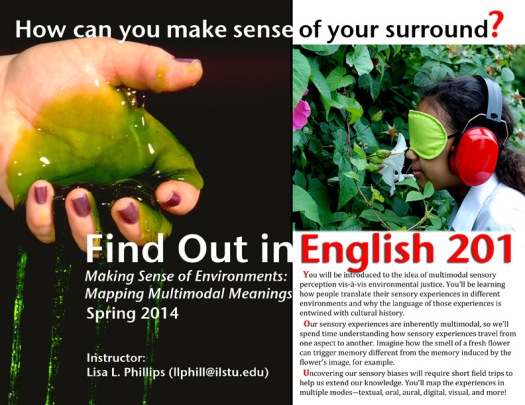I am able to propose a new course that will help me work toward the goals of the NSF Project InTeGrate grant I have received. The course will allow me to work with students in a multimodal context. I have posted the description below and will make periodic posts here as I design the course over the next few months.
I have proposed a section of English 201 Specialized Knowledge and Integrative Contexts in English Studies.
Course Title:
“Making Sense of Environments: Mapping Multimodal Meanings”
Books or Book Excerpts (some will be e-copies available in ReggieNet or through Milner):
Constance Classen, David Howes, and Anthony Synnott. Aroma: The Cultural History of Smell. London: Routledge, 2003.
Alain Corbin. The Foul and the Fragrant: Odor and the French Social Imagination. Boston: Harvard U.P., 1986.
Tim Ingold. The Perception of the Environment: Essays in Livelihood, Dwelling, and Skill. London: Routledge, 2000.
Mark Johnson, The Meaning of the Body: Aesthetics of Human Understanding. Chicago and London: University of Chicago Press, 2007.
Doreen Massey. Space, Place, and Gender. Oxford: Blackwell, 1994.
Mark A. Smith. How Race is Made: Slavery, Segregation, and the Senses. Chapel Hill: UNC, Press, 2006.
Additional readings, and e-copies if applicable, will be available in ReggieNet, our Sakai-based learning management system, or hosted by Milner Library for reasons pertaining to copyright restrictions.
Course Description:
This class is an introduction to the language and rhetoric of multimodal sensory perceptions vis-à-vis environmental justice initiatives. Put differently, we’ll be learning how people translate their sensory experiences in different environments and how the language of those experiences becomes entwined with cultural history. Because our sensory experiences are inherently multimodal, we will spend much of our time understanding how our sensory experiences travel from one aspect to another. (Think, for example, how the smell of a place or thing may trigger a specific memory.) As a result, this course will require short field trips to different environmental settings, and we’ll learn about those settings as well. During the course we will map our experiences in multiple modes—textual, oral, aural, digital, visual, and so forth. Learning to read our sensory experiences is an interpretive, iterative, and culturally informed process. Informed action to redress environmental (in)justice requires that we understand how, why, and when our senses collude to persuade us to act (un)ethically toward other people.
In addition to our field trips, and multimodal work, we will also learn about concepts that address embodied sensory perception, the environment, and sensory rhetoric. We will do this via texts, documentary films, podcasts, and from invited speakers.
Course Format:
The course engages the senses. As such participants are expected to read, compose, discuss, listen, orate, feel, visualize, taste, and smell. This course will also function as a rhetoric course and a workshop for sharing our ideas.

